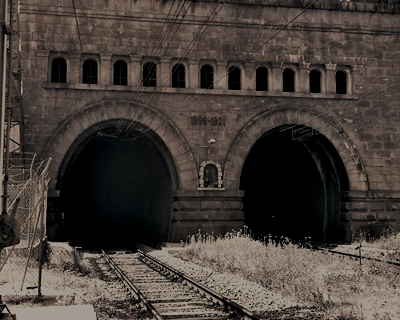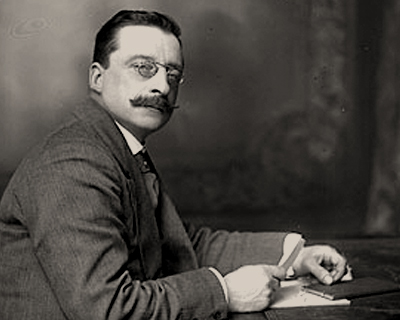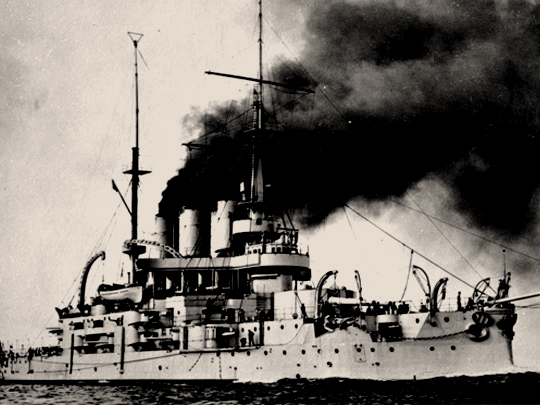Wikimedia Commons / CC-BY-SA-3.0 / GFDL
1 – Mutiny on Battleship Potemkin
The Potemkin was a new battleship of the Black Sea fleet, with a crew of 800. At sea on June 14th, the cooks complained that the meat for the men’s borscht was riddled with maggots, but the ship’s doctor decided the meat was perfectly fit to eat.
A group of men went to Commander Giliarovsky, about worms in their soup. Their spokesman, a man named Valenchuk, expressed himself in such a manner that Giliarovsky flew into a rage, and shot him dead on the spot.
The others seized Giliarovsky and threw him overboard. As he struggled in the water he was shot and killed.
The ship’s captain, doctor and several officers were killed, while the rest of the officers were shut away in a cabin. The ship headed for the port of Odessa, where strikes had been ongoing for two weeks, with clashes between demonstrators, Cossacks, and police.
Valenchuk’s body was given a guard of honor and placed close to a flight of steps. A paper pinned on his chest read, “This is the body of Valenchuk, killed by the commander for having told the truth. Retribution has been meted out to the commander”.
This would be immortalized in the famous ‘Odessa Steps’ sequence of Sergei Eisenstein’s propaganda film, The Battleship Potemkin.
The Tsar’s Troops were sent to the harbor, and at about midnight opened fire on the packed crowd, which had no escape route. Some people were shot, while others jumped or fell into the water and drowned.
The casualties were put at 2,000 dead and 3,000 seriously wounded.
Calm was restored, and Valenchuk was given a decent burial, but the sailors’ calls for amnesty were turned down. The crew had been hoping to provoke mutinies in other ships, but the few minor disturbances were easily quenched.
On June 18th the Potemkin set sail for the port of Constanza in Romania, where they refused to surrender the ship. However, having been driven off after sailing to Crimea, they returned and surrendered to the Romanian authorities in Constanza on June 25th.
2 – Simplon Tunnel in Switzerland was completed

The Simplon Tunnel is a railway tunnel that connects Brig, Switzerland and Domodossola, Italy, through the Alps, but not under Simplon Pass itself.
It is straight except for short curves at either end.
It consists of two single-track tunnels built nearly 20 years apart. They measure 19,803m and 19,824m long, making it the longest railway tunnel in the world until the opening of the Daishimizu Tunnel in 1982.
Work on the first tube of the Simplon Tunnel commenced in 1898. The Italian King Victor Emmanuel III and the president of the National Council of Switzerland Ludwig Forrer opened the tunnel at Brig on 10 May 1906.
The builders of the tunnel were Hermann Häustler and Hugo von Kager.
3 – Sinn Féin founded by Arthur Griffith in Ireland

Wikimedia Commons / CC-BY-SA-3.0 / GFDL
It is generally acknowledged that 28 November 1905 is the founding date of the party, as it was on this date that Griffith first presented his ‘Sinn Féin Policy’.
In his writings, Griffith declared that the Act of Union of Great Britain and Ireland in 1800 was illegal and that, consequently, the Anglo-Irish dual monarchy that existed under Grattan’s Parliament and the so-called Constitution of 1782 was still in effect.
The fundamental principles on which Sinn Féin was founded were outlined in an article published in 1904 by Griffith, in which he noted how in 1867 Hungary went from being part of the Austrian Empire to a separate co-equal kingdom in Austria-Hungary.
Though not a monarchist himself, Griffith advocated that Ireland should become a separate kingdom alongside Great Britain, the two forming a dual monarchy with a shared monarch but separate governments.
He thought this solution would be more palatable to the British. However, this idea was never really embraced. Central to his strategy was parliamentary abstention.
This was the belief that Irish MPs should refuse to attend the Parliament of the United Kingdom at Westminster, but should instead establish a separate Irish parliament in Dublin. Sinn Fein’s first president was Edward Martyn.









